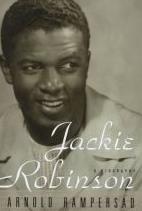I have to admit that I was a little nervous about how “42” would handle history when I entered the dollar-movie theater. (Yes, I am cheap. And now you know why my reviews come so long after a film is released).
Of course, the film did well with the material items: three-fingered gloves, 47 Chevys, the metal grill doors in the airport, flannel uniforms and steel girders in the stadiums. (There is that problem with the slope in Crosley Field, but we’ll let that pass). The material items are the easiest part of history to get right in films, so I wasn’t too concerned about that part.
No, I was worried about how the filmmakers would handle race. They did a fairly good job, in my estimation.
Let me explain my concern. Have you seen that movie with heroes whom you root for on one side, and bad guys on the other, and there is a complicated and tense conflict between them, but the good guys win in the end? It’s called Star Wars. Or maybe it’s Spider-Man. Or Rocky. Or The Little Mermaid. Or The Wizard of Oz. Or Independence Day. Or Cinderella. Or Raiders of the Lost Ark. Well, I don’t know. It’s one of those movies. Or maybe one or two that I haven’t mentioned.
If you haven’t noticed, we Americans like films that fit into this simple narrative. We, the viewers, naturally identify with the good guys (in the old cowboy movies they wore white hats, just to be sure you got it) and we cheer against the bad guys. And then good wins out, and we all leave the theater feeling fine, especially since we were on the right side.
This can happens with films about race. We want to put ourselves on the sides of those fighting racism. We want those bad racists to lose out to freedom, justice and equality. And when they do, we all leave the theater feeling fine, especially since we were on the right side.
But reality, human nature and race is much more complicated than that. How do we know we would have been on the right side in 1947 or 1852 or 1666? And can we really divide humanity into good people and bad people?
Mississippi Burning is among the worst films on this score. The FBI agents are the heroes and we root for them because we, like all decent Americans at the time, were on the side of justice, right? Just about every white southerner in the film, meanwhile, is a redneck racist. With those ignorant accents. And they’re ugly, too. Boy I’m glad we’re not like them.
Usually, (and by “usually,” I mean “every time”) when a film that is “based on a true story” divides the good from the bad in such a clear-cut and simplistic way, the film is distorting history. Exhibit A: in real life, the FBI spent most of its resources investigating the “trouble-making” civil rights movement, not those who killed civil rights workers.
I was relieved, then, to see a somewhat more complex picture of race emerge in “42.”
Yes, the ugly racists are there – most notably the Phillies manager, Ben Chapman, whose racist taunting of Jackie Robinson had me squirming in my seat. (There’s a little bit of the simplistic “feel good” motif here, as we all smile with gratification in the credits when we find that Chapman never managed in the majors again after that season. Yeah, take that, you racists!)
But one of the fine qualities of “42” is that one gets a range of racial responses from the characters in the film. Robinson’s minor league coach welcomes him, but expresses a disparaging attitude about the ability of “niggers” to play ball (an accurate historical characterization of the guy). The players on the Dodgers were initially cold, but eventually displayed a range of different reactions, from outright opposition, to conflicted feelings, to gradual respect, to open support – another accurate characterization.
One of the best scenes occurs after Robinson has been on the Dodgers for several weeks and the team is about to play in Cincinnati for the first time. Pee Wee Reese, who was from nearby Kentucky, comes to general manager Branch Rickey’s office because he has received a threatening letter for playing with Robinson. Having never faced anything like this before, he wants Rickey to do something about it. Rickey (whose crustiness is overdone by Harrison Ford — sorry, but his acting bugged me) then pulls out file after file after file of death threats that Jackie Robinson has been receiving all along.
The beauty of the scene is that we the audience, like Reese, are bothered by the idea he has received this threat; we feel the sting of racism. But when it is revealed that Robinson has been receiving a constant barrage of threats, we realize that he has been living with something much, much worse for quite some time. It is hard for those of us who are white to fully understand what the world looks like to blacks. Through this scene we, like Reese, get just a slight glimpse of the sort of pressure that Robinson had to play under (though it was even worse than the film portrayed it: Robinson also received death threats directed at his wife and threats to kidnap his infant son).
 Reese began to see this. And that is why, in one of the more memorable scenes in the film, as Robinson is jeered and taunted by the fans in Cincinnati, Reese walks over and very purposefully puts his arm around Robinson and talks with him in solidarity for a moment. We empathize with Reese, who empathized with Robinson.
Reese began to see this. And that is why, in one of the more memorable scenes in the film, as Robinson is jeered and taunted by the fans in Cincinnati, Reese walks over and very purposefully puts his arm around Robinson and talks with him in solidarity for a moment. We empathize with Reese, who empathized with Robinson.
It’s a great scene. And it didn’t happen.
Well, it sort of happened, just not in the dramatic fashion portrayed in the film. I have not seen any historical evidence that Rickey pulled out the file of threatening letters to show Reese what Robinson had been enduring. That seems to be a dramatic invention by the filmmaker. More famously, (and despite a statue in Coney Island commemorating the event) it is unclear whether Reese put his arm around Robinson in Cincinnati in 1947. We don’t have filmed footage or same-day accounts of the event. Two years later, Robinson said something like this happened, though he thought it might have been in Boston and it might have been 1948. Others put it in Cincinnati. And Reese might not have put his arm around Robinson.
As a historian, though, I’m fine with this scene.
Filmmakers have to invent all sorts of things in film. They make up almost all the dialogue. They have to arrange scenes in ways that hold together and hold our attention. They have to build some sort of drama. Real life is never so neat and tidy and dramatic. But I’m fine with the scene because it draws the viewers into a better understanding of Robinson. It also reflects some level of transformation within Pee Wee Reese, who was not an avid supporter of Robinson in the beginning, but did become someone that Robinson counted as a friend. (He was one of Robinson’s pall bearers at his funeral). So it reflects what was true about Reese and Robinson.
The portrayal of Reese should give us hope that we can be transformed as well. That is a much better position for us to be in. We haven’t conquered the problems of race (or any number of other things) yet. So it is better that we ask for grace, wisdom and humility, than to thank God (like the man in a certain parable) that we are not racists like those ugly redneck southerners…..
 By the way, even if you are not a baseball fan, you should read Jackie Robinson by Arnold Rampersad. It is one of the best biographies, of any kind, that I have read.
By the way, even if you are not a baseball fan, you should read Jackie Robinson by Arnold Rampersad. It is one of the best biographies, of any kind, that I have read.
Also, I’m off to Brazil for two weeks, so there will be another lull in my blogging.















